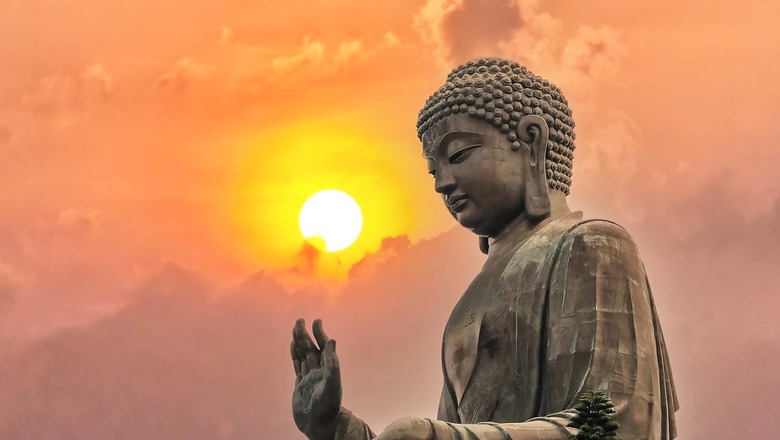
views
2500 years ago, on a full moon day, a child took birth in a place called Lumbini to the Shakya king Suddhodana and queen Maya Devi. He was named Siddhartha Gautam. Some people in the kingdom had an inclination that Siddhartha will become a great king and will bring much prosperity to the state. Being the son of a king, Siddhartha grew up in great luxuries and was married at the age of 16 to a beautiful girl named Yashodhara with whom he had a son Rahula. Up to this stage of his life, everything was normal. He was enjoying the palace life, marital bliss and all the care and comforts of being a prince.
But then, one day, while on a leisure trip to the city, Siddhartha saw four life-changing sights which he had never seen before and these four sights not only changed the course of his life but also the course of humanity going forward. On that day, Siddhartha saw an old dilapidated man with a bent body and asked his charioteer ‘Channa’ about it. Channa said, “Yes Siddhartha, with age and time, every person grows old, the strength leaves the body and all senses become weak.” A little further, Siddhartha saw a very sick man in deep pain and enquired about it from his charioteer, Channa, to which he replied, “Yes Siddhartha, the human body is susceptible to illnesses and every person experiences some form of illness and pain during his lifetime.” Just a little further, Siddhartha saw a dead man and people wailing around him. On this sight, Siddhartha was deeply disturbed and asked Channa about it, Channa said, “Yes Siddhartha, this is the final outcome of human life, nobody can escape death, whoever has taken birth will die, death is inevitable.” Hearing this, Siddhartha felt a deep despair and hopelessness about life in his heart, his face turned pale with sadness and eyes wet with sorrow. While experiencing these heart-shaking realities of life, suddenly Siddhartha saw a meditating sage and asked Channa who he was. Channa replied, “O Siddhartha, this is a sage who has renounced everything that the world is chasing to acquire, he seems to be dwelling in an internal space of bliss, free from all pains and pleasures, he is meditating to realise his inner self, to know the truth of life and to achieve eternal liberation.” Hearing this, Siddhartha asked, “Is this liberation possible for anyone?” and Channa replied, “Yes Siddhartha, that is what I have heard.”
These four sights, which the Buddhist call, ‘the four noble signs’ put Siddhartha on the path of self-discovery which finally resulted in his nirvana (enlightenment). This is when Siddhartha Gautam became ‘The Buddha’, the enlightened one. Buddha’s awakening and his path to this awakening which he taught to hundreds and thousands till the end of his life, is still transforming the lives of millions of people across the globe even today. These four noble signs are visible to everybody because these are integral parts of life, but very few people really observe these signs or take a pause to contemplate them and realise the truth of existence.
If we observe carefully, the first three signs are about inevitable realities of life i.e., old age, illness and death. No matter how much anyone tries to avoid or postpone these three realities, one cannot escape them. It does not mean that maintaining good physical and mental health is not important, in fact, without physical and mental well-being, nothing is possible in life. But at the same time, the truth is that at some stage of life, old age catches up, some form of illness and related pain or uneasiness is experienced and finally death comes, which is the most certain reality of life. None of these three signs can be avoided, no matter how hard one tries, such is the nature of life on Earth.
And the fourth sign, the sign of meditating sage, is about great possibilities, it is a way to transcend all dualities of pleasure and pain, attraction and repulsion. It is the surest way to move beyond the bondage of body-mind construct and move into an inner space of limitlessness, a state where everlasting bliss becomes a living reality. Different traditions and people use different terms to refer to this state of highest consciousness like nirvana, shoonya, nothingness, moksha, awakening and so on. The full moon day when Siddhartha Gautam was born is celebrated among Buddhist cultures across the globe as Buddha Purnima (full moon day of the Buddha). Buddha Purnima is a powerful reminder that a journey towards truth, bliss and awakening is possible for everyone and like Siddhartha Gautam, every human being carries the potential to be ‘The Buddha’, the awakened one.
The author is an ex-corporate CEO & a successful entrepreneur. In 2006, he moved to the Himalayas & spent over a decade on his deeper spiritual quest. After this sadhana period, he was guided to move back into public life to bring spiritual awakening to the world through his talks, writings, retreats, programs and works of seva. Views expressed are personal.
Read all the Latest Opinions here


















Comments
0 comment